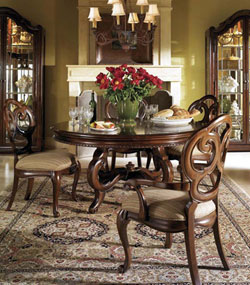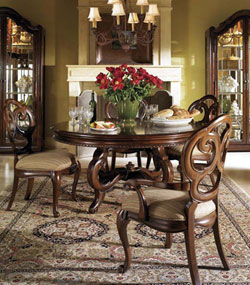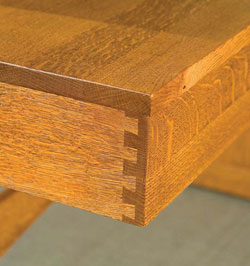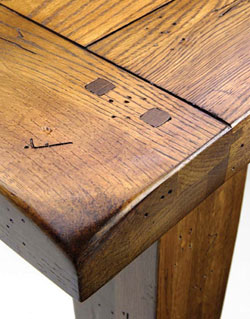Buying Guide: Wood Furniture

| WOOD FURNITURE SHOPPING CHECKLIST |
Wood Source
- Hardwood__________
- Softwood__________
- Engineered Wood
- Veneer
|
Finish
- Stain_____________
- Hand-Rubbed
- Distressed
- Antiqued
- Painted
|
Construction
- Levelers
- Corner Blocks
- Dust Panels
- Back Panels
- Dovetails - English
- Dovetails - French
- Drawer Glides
|
Pieces
- Desk
- Return
- Hutch
- File Cabinet
- Computer Armoire
- Wall System
- Chair
|
When you purchase wood furniture, no matter the function, there are several
quality indicators to look for. The type of wood, the finish and the construction
should be scrutinized when looking for a quality piece. We also have helpful
checklists for buying Beds and Bedroom Storage, Dining Sets and Occasional
/ Accent Furniture, and Entertainment Centers. These guides will help you
understand differences in quality construction and help you find furniture
that will withstand the wear and tear of modern life.
 Wood Source
Wood Source
There are two primary categories of natural wood used in furniture construction:
hardwood and softwood. Hardwoods come from deciduous trees (the ones that
loose their leaves in autumn) such as maple, walnut, mahogany and oak Softwoods
come from coniferous (also known as evergreen) trees and include species such
as pine, cedar and redwood. Both varieties are used for furniture construction
with hardwoods valued for their strength and durability, and softwoods for
their easy tooling and shaping.
Engineered wood is any variety of wood fibers, particles, or veneers adhered
together with a bonding agent. Furniture bearing the description "All-Wood"
is frequently composed of engineered wood products. Engineered woods are less
prone to warping due to variations in humidity, and in some cases, offer a
stronger substructure. Engineered wood may also be viewed as environment-friendly
since it uses of lumber that might normally go to waste.

Veneers are a time-honored technique of furniture construction and should
not be considered a sign of inferior construction or materials. Veneers have
been used in furniture construction since the ancient Egyptian era as a decorative
effect. Veneers can be used to create intricate patterns on the surface of
furniture with grain matching or with marquetry and intarsia inlays. Veneers
are often made from highly-valued woods like mahogany and walnut, or exotic
woods like tiger wood and maple burl. Veneers are applied to both solid wood
and engineered wood substructures.
Laminates are constructed by the adhesion of a paper product, printed to look
like wood grain or other appealing pattern, to an engineered wood substructure
and then sealed with a protective finish. Laminate products have gained popularity
in the flooring industry as a low-maintenance, and low cost, alternative to
hardwood flooring.
Finish
Stains are used to alter the natural color of the wood. Furniture with a "cherry
finish" is not necessarily made with cherry wood; more likely, another hardwood
was used for the construction and then stained to look like cherry wood. Stains
have been used on furniture for centuries as dictated by home dé cor
trends. Stains consist of thin pigments that are absorbed into the grain of
the wood. A wax, oil, polyurethane, shellac or lacquer finish is applied over
a stain to protect the wood surface.

Distressing is a finishing technique that artificially creates a weathered
look. Sanding, punctures, or gouges on the wood surface help to create the
effect.
Antiqued finishes employ distressing as well as stains to simulate the aged
patina of an antique.
Painted finishes can be solid and even, or antiqued and distressed. Natural
flaws in wood, such as knots, can absorb paint finishes differently; therefore,
solid paint treatments can be difficult to create, and thus may be more costly.
Distressed painted finishes often have sanded edges and corners that allow
the natural wood color and grain to show through.
A number of different products may be used to protect a wood surface. Wax,
oils (linseed oil or tung oil), polyurethane, shellac, and lacquer bring a
unique character to the wood as they protect it. Whatever material is used
in the finishing process, the final product should be smooth to the touch.
A hand-rubbed finish is "rubbed-out" or buffed with abrasives or cloths after
application of the finishing materials. It leads to a smoother, more refined
final surface.
Construction and Components
High quality wood furniture will feature construction techniques and components
that increase functionality and lengthen lifespan.

Levelers or adjustable floor glides are components on the feet that may be
adjusted up or down so that the piece doesn't wobble. This is an important
feature since leveling ensures the proper alignment of doors and drawers.
Corner blocks reinforce the corners of case goods and drawers to improve strength
and stability. Corner blocks are not seen from the outside, but bolt to both
sides of interior corners.
Dust panels are thin sheets of wood between drawers in the body of a chest
or desk. They help to keep clothing or other materials in the drawers clean
by preventing the infiltration of dust. They also add to the structural integrity
of the piece, making it stronger and sturdier.
Back panels are the generally unseen backs of case goods that are placed against
the wall. Quality case goods have back panels attached with screws to help
ensure the lateral stability.
Dovetails are a sturdy construction technique, usually employed in drawer
construction, consisting of interlocking tenons of wood. English dovetails
consist of interlocking fan-shaped wedges. French dovetails are constructed
with one long groove, which is narrower at the surface and wider at the depth,
into which slides an interlocking end of a board. Given two chests of similar
scale, drawers constructed with French dovetails will offer less storage capacity
than drawers constructed with English dovetails because of the required overhang
of wood on the front panel.
Drawer glides allow you to effortlessly move a drawer in and out of its station.
They can be made of wood, metal, or nylon, or combinations of these materials.
Glides can be side mounted or bottom mounted, depending on the case construction.
For example, side mounted glides are more likely to be found on drawers with
French dovetails. Wood is a strong material for drawer glides since it expands
and contracts with changes in humidity, just like the rest of the piece. Glides
in office furniture such as desks, file cabinets and computer armoires are
important to the functionality of the piece. Metal compound glides in office
furniture allow for the full extension of drawers. They are usually side mounted
and may incorporate ball bearings or nylon roller wheels. This is useful for
accessing file drawers.
Stops, made of nylon or wood, prevent drawers from being pulled out too far
or from falling out when fully extended.
For information on specific categories of wood furniture, see the articles
and checklists below.
How to Buy Beds and Bedroom Storage
How to Buy Dining Room Furniture
How to Buy Home Office Furniture
How to Buy Occasional and Accent Furniture
How to Buy Entertainment Centers




